The succulent is one of nature’s most efficient plants, and one of the easiest to propagate.
It’s a type of “xerophyte,” a shallow-rooted wonder that thrives in dry climates and stores water in fat, fleshy leaves and stems.
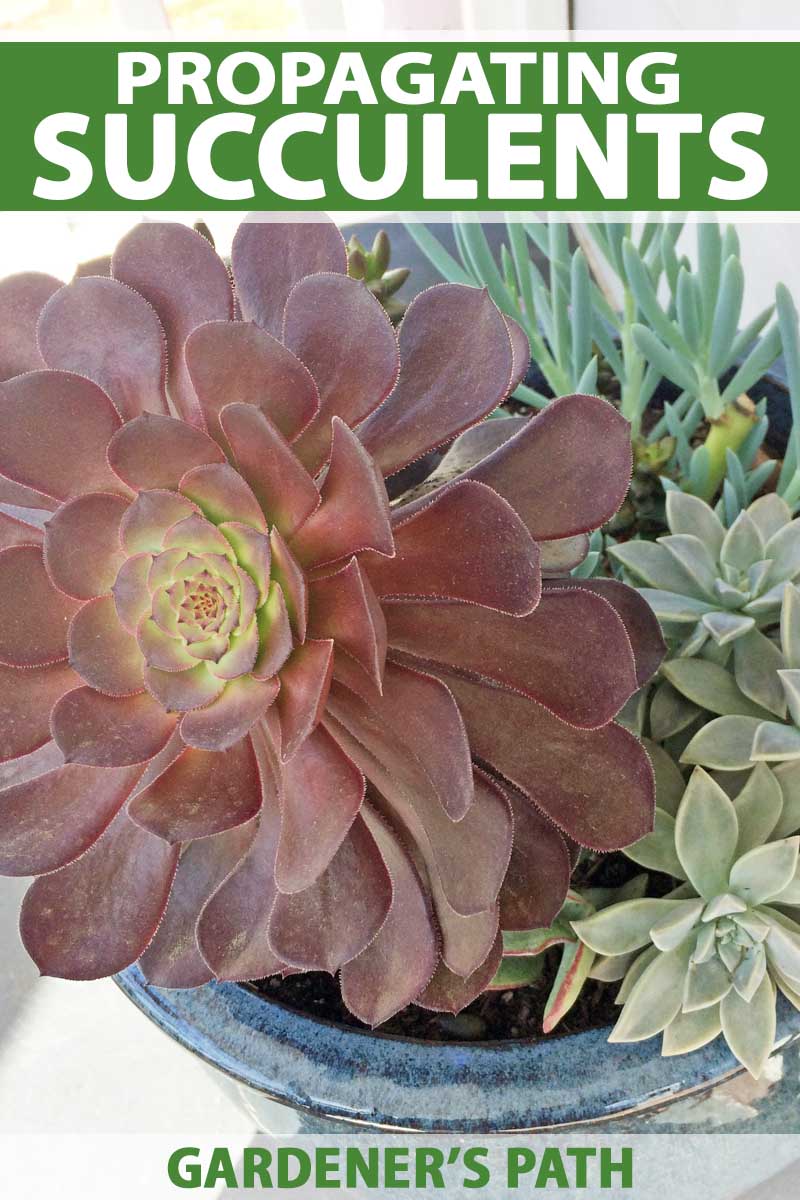
We link to vendors to help you find relevant products. If you buy from one of our links, we may earn a commission.
A Feast for the Eyes
Succulents come in an extensive variety of textures, colors, shapes, and sizes.
From the smooth blue rosettes of echeveria hugging the soil in compact clusters, to the towering six-foot Agave americana stretching toward the summer sun, succulents are varied and fascinating plants.
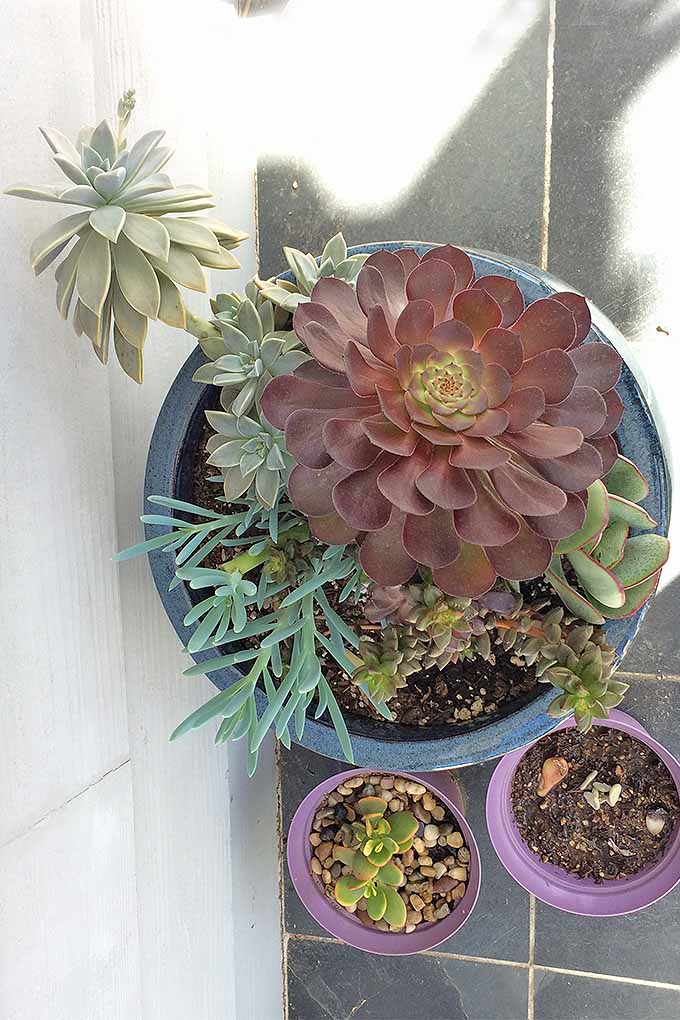
Succulents grow outdoors in temperate climates, and make excellent additions to xeriscapes, where irrigation is minimal.
They’re at home between pavers, in rock gardens, and peeking out from crevices in stone walls.
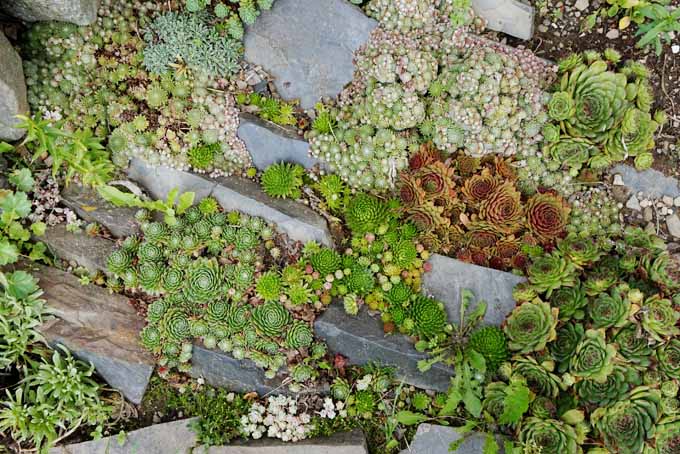
These versatile plants also thrive indoors in pots with good drainage, as well as in terrariums, provided they are watered sparingly.
My favorites are miniature varieties.
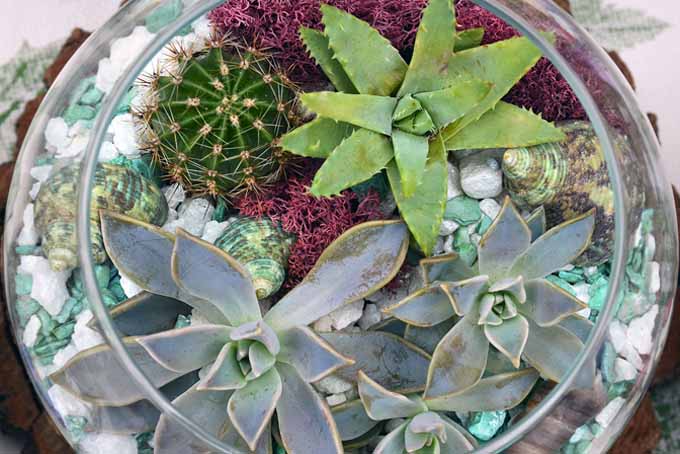
I like to plant them in interesting containers, grouped to create an eclectic desertscape.
You’re going to fall in love with these low-maintenance beauties, and knowing how to propagate them means you can grow as many as your heart desires.
Be Fruitful and Multiply
Succulent plant propagation is a breeze. Of course, you may start from seeds, but it’s easier and faster to use the plants you have to produce even more.
Here are two easy methods:
Dividing
You may divide a plant in two ways.
1. Plantlet Removal
Remove plantlets, or offsets, that have sprung up alongside the mother plant.
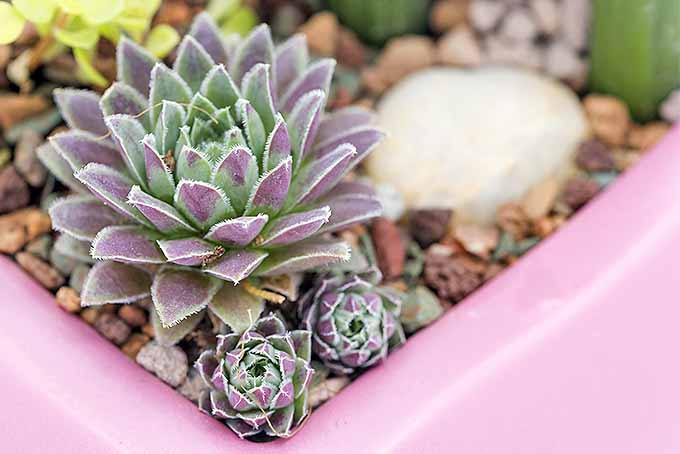
These are fully-formed and rooted mini-plants that can grow independently.
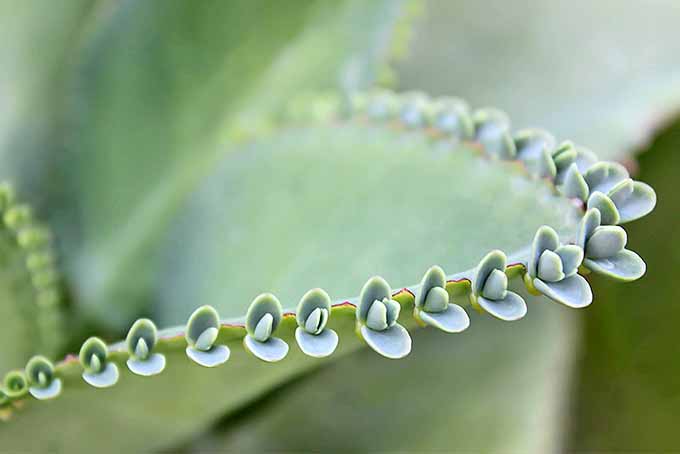
With echeveria, a rosette-forming succulent, we call the main plant the “hen” and the plantlets are referred to as “chicks.” With barrel cactus, they are known as “pups.”
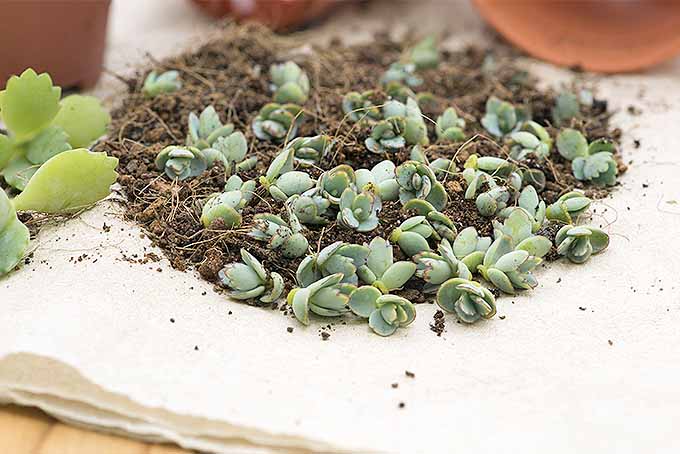
Some succulents drop plantlets. Like seeds, they take root where they fall.
2. Root Separation
Unearth an entire plant and gently tease the roots apart. Plant the separated clumps individually.
Plants that have been divided by root separation may be placed in soil immediately.
For indoor plants, use a potting medium recommended for cactus and succulent plants, like Hoffman Organic Cactus and Succulent Soil Mix, available via Amazon.
You can also mix a handful of sand or perlite into potting soil. The proper mix promotes drainage and provides nutrients.

Hoffman Organic Cactus and Succulent Soil Mix, 4 Quarts
Wait a day, then water sparingly.
Return outdoor plants to the garden when the sun is not directly overhead. Work the soil until it is crumbly, mound it up a bit, and make a shallow depression with room for sprawling roots.
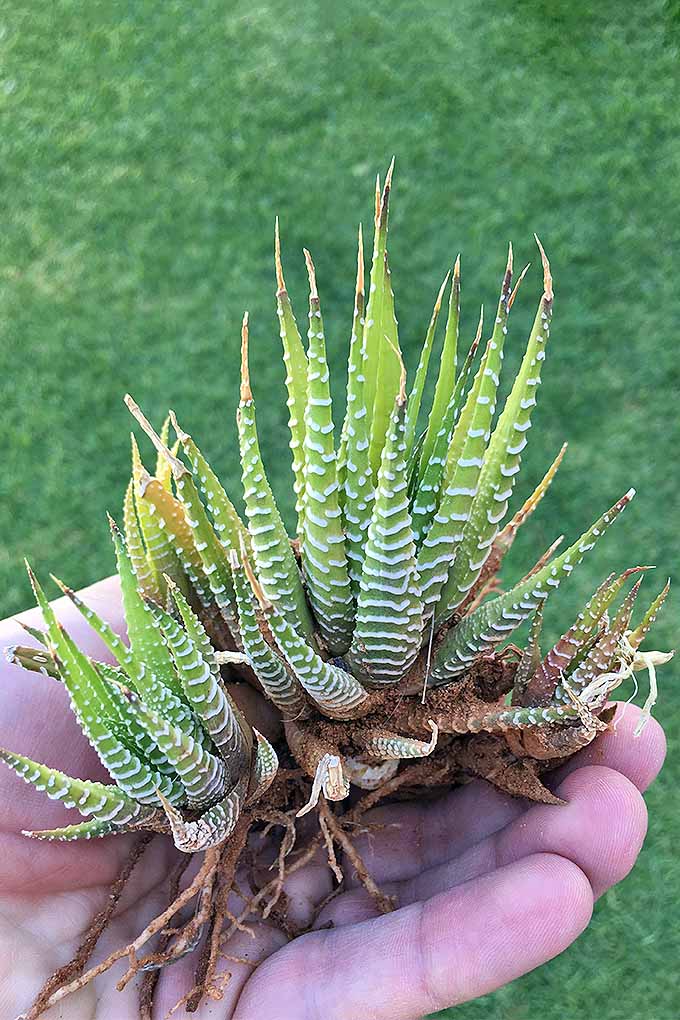
Nestle your plant carefully into it and gently cover the roots with about an inch of soil. Tamp gently to secure.
Wait a day, and then lightly water the soil around the plant.
Cutting
With the cutting method, just cut off a piece of leaf or stem, let it dry, and you’ll have roots and shoots in no time. The trick is to keep it totally dry.
Here are two methods:
1. Leaf Removal
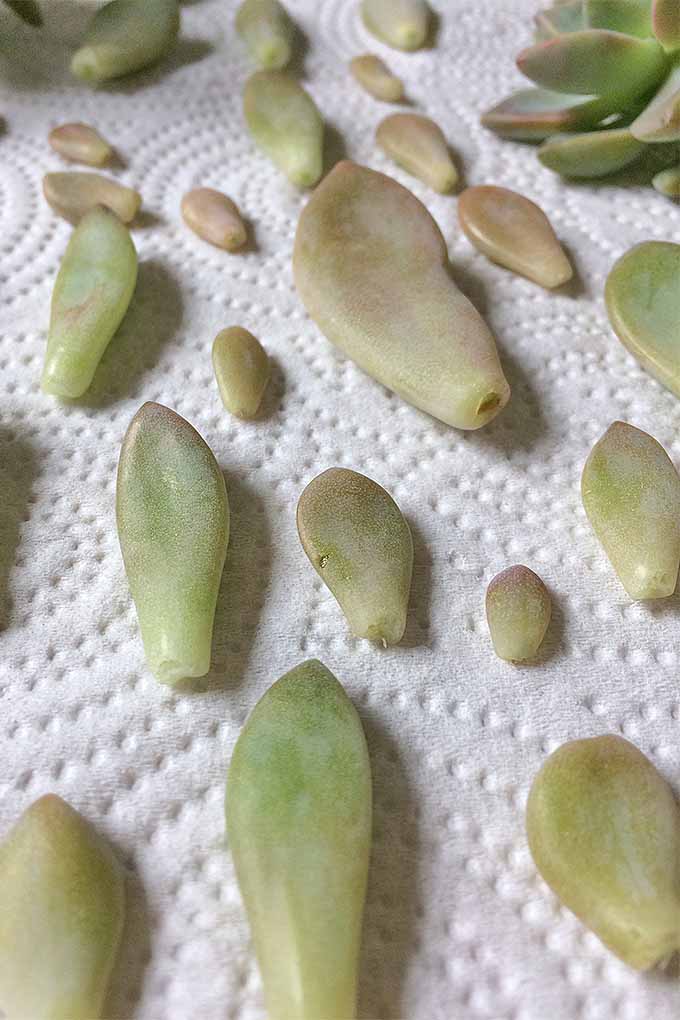
Randomly remove several leaves, dry them out, let them grow roots, and plant.
2. Beheading
This is a good fix for a plant that has grown tall and spindly, or whose leggy bare limbs drape downward like a pendant.
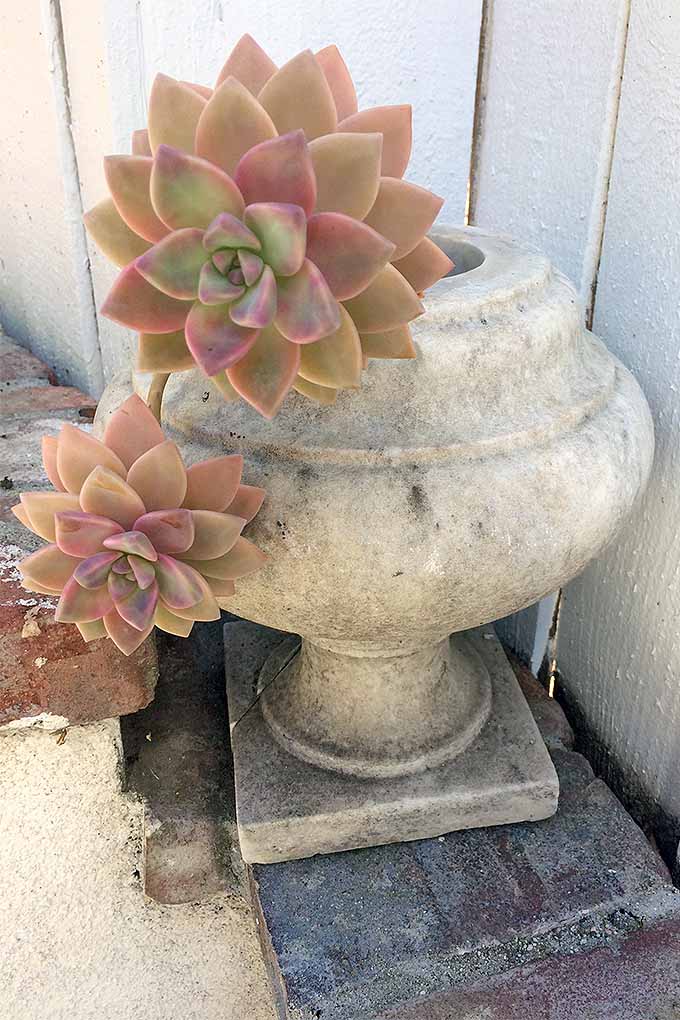
Simply cut the head of the plant off the lengthy stem, leaving about an inch of stem attached. Dry it out, let it grow roots, and plant.
The remaining stem of a healthy beheaded plant should grow new leaves in a compact grouping, making for a sturdier, more attractive plant.
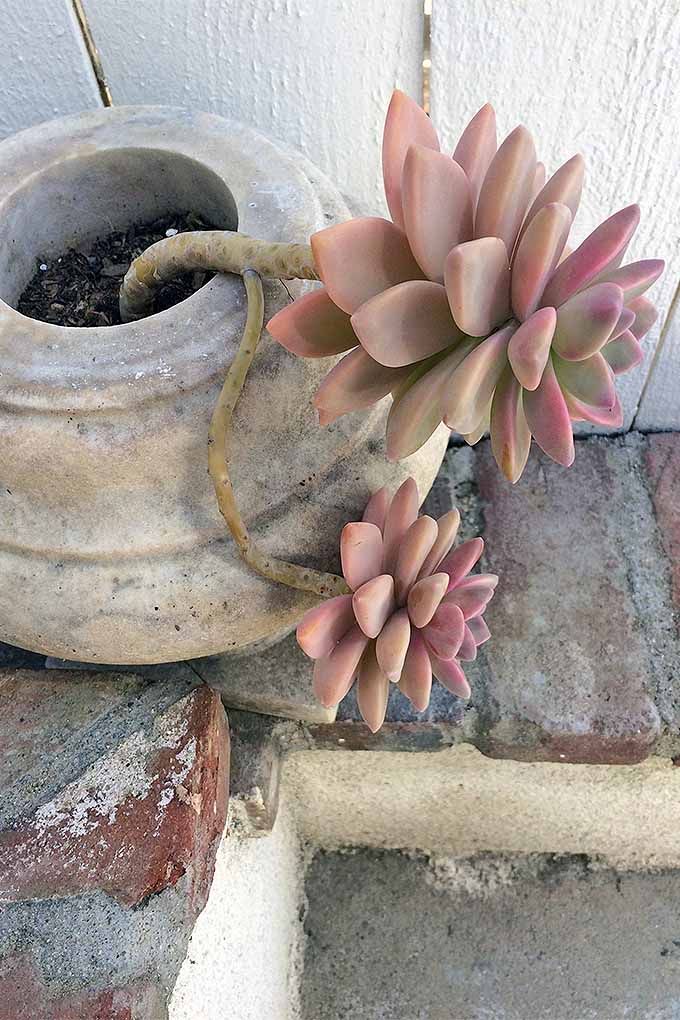
As indicated, cuttings made from leaves and plant heads must dry out and grow roots before planting.
It’s not hard! Here’s how:
Propagating Succulent Cuttings
What You’ll Need:
- Sharp shears
- Garden gloves (for handling spiny varieties)
- Small trowel
- Potting medium for succulents and cacti
- Containers with adequate drainage holes
How To:
1. Remove Some Leaves or Behead
Randomly remove a few leaves from your succulent plant, twisting gently to remove the entire leaf without tearing.
On leggy growth, these can be removed from the bottom portion of the stem, which will be discarded.
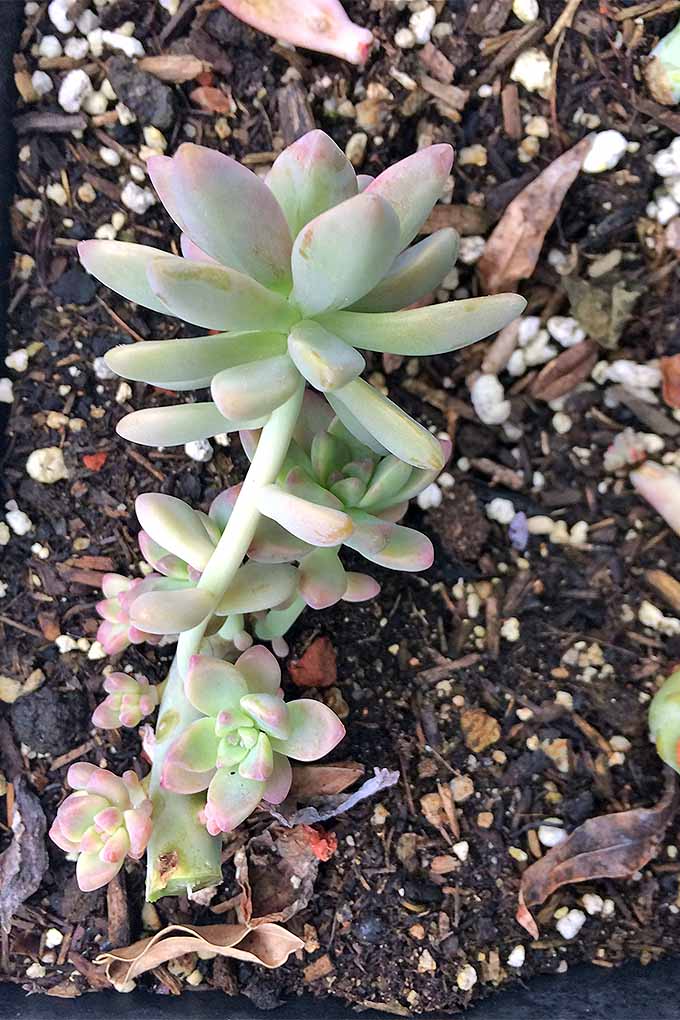
For plants like Christmas cactus, you may need to use scissors to remove an individual leaf.
If you are “beheading,” use your scissors or clippers to cleanly cut the stem about an inch below the lower leaves of the plant head.
2. Callus Off
Set the cuttings aside in any type of container or tray.
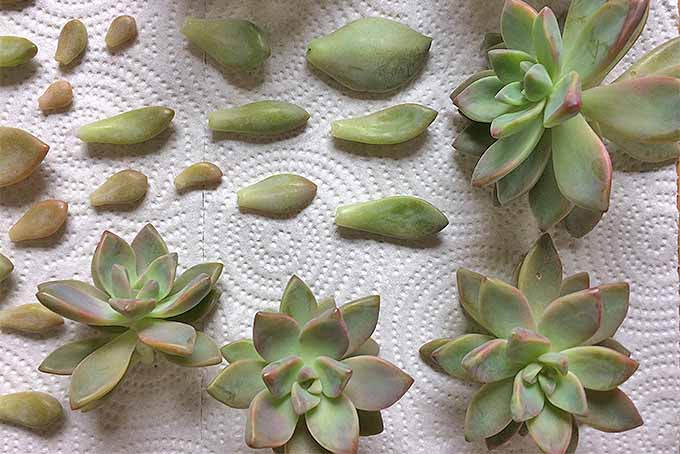
They’re not fussy. No potting medium or water are needed.
Check them in about five days and see if each has formed a callus on the cut end.
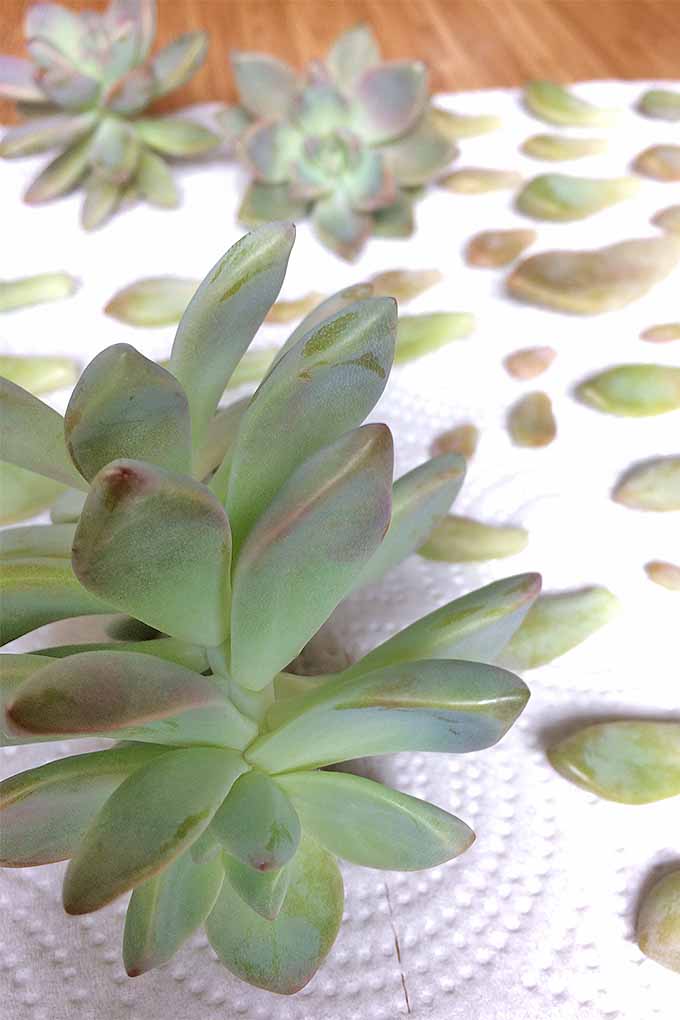
This protects the exposed soft tissue from bacterial penetration.
3. Grow Roots
Watch for the growth of roots over the next few weeks.
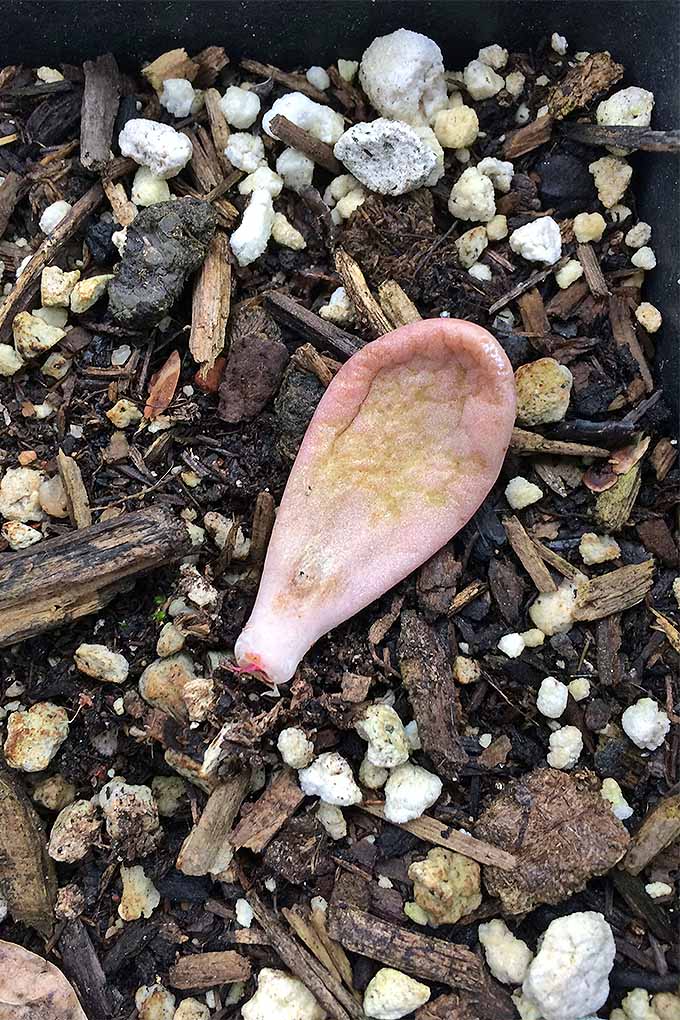
Leaf cuttings will begin to wither as they become food for emerging new plants.
4. Plant
When roots form, fill well-draining containers of your choice with potting medium, or select a garden location suitable for planting.
You can also opt to mix a handful of sand or perlite into regular potting soil.
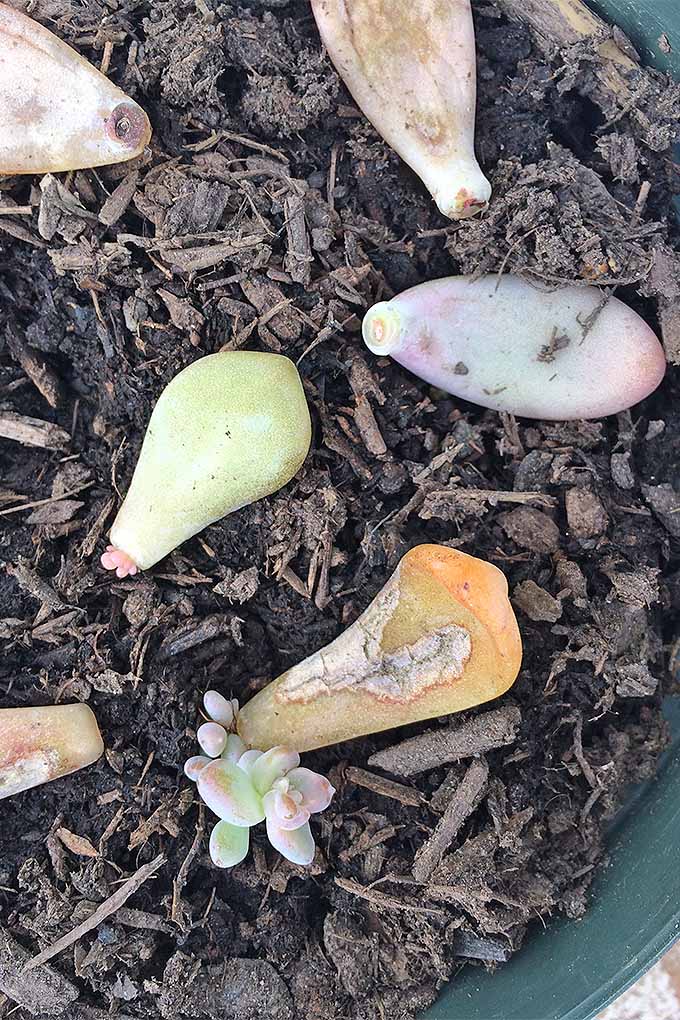
Succulents thrive in sunshine and well-drained soil. Without sun, they grow pale, and with too much water, they rot.
Plant in a sunny spot in early morning or late afternoon, when the sun is less intense.
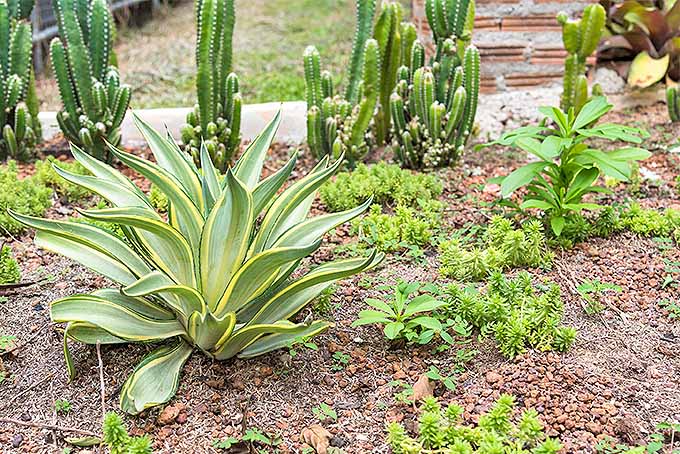
Mound soil up to raise the cuttings above the edge of your container, or garden surface. Gently tamp the soil down to secure the roots, and do not water.
Embellish with decorative stones or pebbles as desired.
5. Water and Feed
The next day, water sparingly and gently tamp the soil down again.
As your new plants acclimate to their surroundings, growth will accelerate.
At this point, it’s time to purchase a succulent/cactus food, like Miracle-Gro Succulent Plant Food, available on Amazon. Administer per manufacturer’s instructions.
There are other techniques for propagating succulents, including placing cuttings on top of potting medium to callus off, thus enabling them to root themselves directly into the soil.

Miracle-Gro Succulent Plant Food, 8 Oz.
This method is great if you want to start your own potting nursery for many cuttings at once, however, you must keep the soil completely dry while the cuttings callus off and form roots.
Plan to spend a few weeks on the propagation process, trying various methods and noting results. A gardening journal is great for record-keeping.
A Note on Cactus Propagation:
Propagating succulents is easy and fun. From a plantlet, division, leaf cutting, or beheading, you can increase your collection of these beauties.
By now you may be curious about types of cactus we haven’t mentioned.
We know this: barrel types form pups that may be harvested and planted individually. And, Christmas cacti have individual leaves that may be cut, callused, and rooted. But what about others, like column varieties?
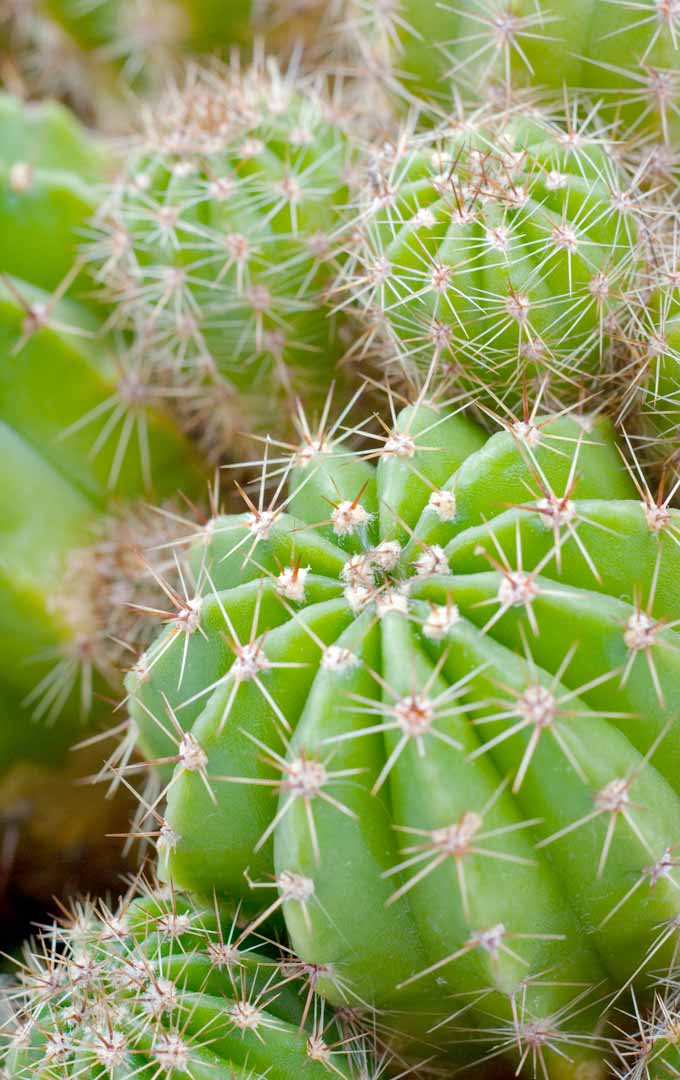
We propagate by cutting.
Since the entire cactus is one giant leaf, the question is, where do we cut?
Simply cut into the top or side of a columnar cactus and remove a piece about an inch in diameter. Place it on a dry surface that won’t be disturbed and forget it for a few months.
During this time, provided it remains dry, the cutting will callus off and form roots. Then it’s ready to plant.
Stalwart and Stunning
I’m fascinated by succulents.
They make a spectacular display when planted in multi-variety groups, forming a tapestry of living colors, shapes, and sizes that remind me of a deep-sea coral reef.
So hardy and vibrant, it’s hard to believe that they grasp the soil with roots that are barely threads, and require scarcely a thimbleful of water to thrive.
Heed the need for little moisture and water sparingly!
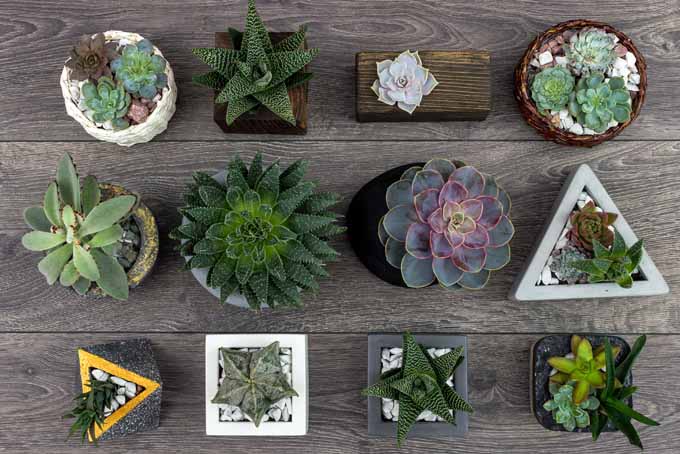
This tip from succulent devotees is helpful: plant rosette-type varieties like echeveria angled downward.
This way, water runs out instead of accumulating and promoting rotting.
Ready, Set, Grow!
What are you waiting for?
It’s time to spruce up your décor with nature’s desert wonders and enjoy what may be the simplest and most rewarding type of gardening you’ve ever tried.
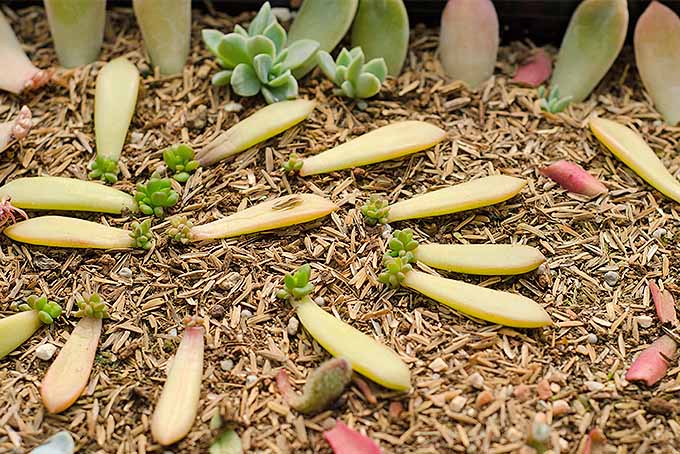
Visit a local nursery and choose succulents that appeal to you. Nurture them and try your hand at growing new plants to share with friends.
And use the techniques described above to propagate these unique plants like a pro.
Do you have a favorite succulent? What plant propagation tips would you like to share? We’d love to know your thoughts in the comments section below.
And for more information on growing succulents, check out these guides next:

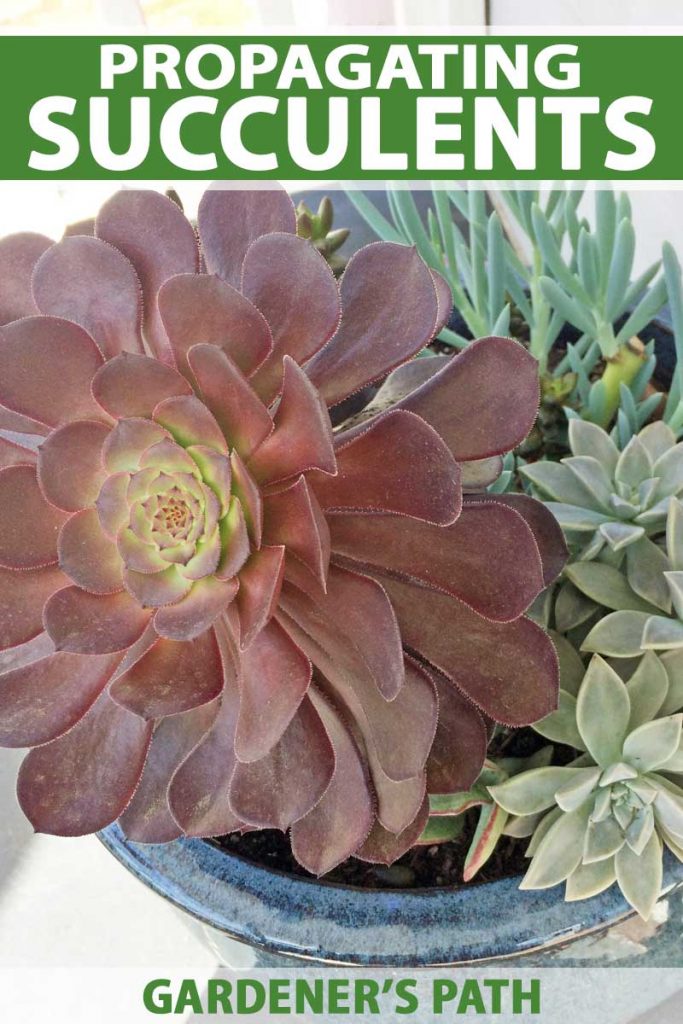
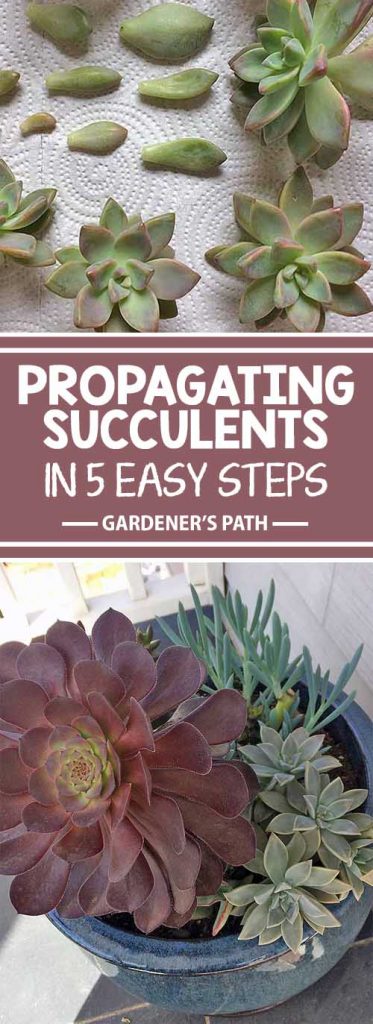
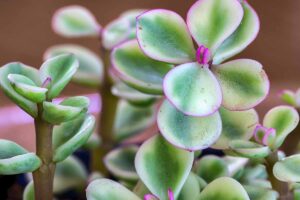
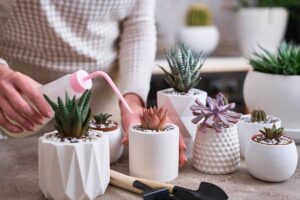

Thanks for this helpful guide.
I have beheaded a few of my leggy plants and after a couple of days the stems on them have gotten shrivelled and limp rather than calloused. Is this normal? Are they still okay to use?
When you behead a succulent, keep them away from direct sunlight for a few days until calloused. PS: some succulent plants like aeonium will wilt alot before it starts rooting
I have some small vine-like succulents. Do I leave them on the top of the soil?
Have they developed roots, Joyce? Propagating the vining species can be more difficult, but not impossible. If you can be more specific about what the species might be, we may be able to provide some additional info to help you out.
So, my family and I had no idea how it works but we ended up using the method of taking the plantlets but they are growing really tall, leggy, I think. Please help.
Leggy growth is an indication that they need more light. To start, try moving them to a sunny location, and remember that potted starts need to be watered more frequently than established succulents typically will.
Hi, when planting the newly propagated cuttings, do you bury the mother leaf it has grown from or what do you do with the mother leaf?
Since the mother leaf contains moisture, it will continue to nourish the new growth. You can either leave it on top of the soil and allow it to dry and fall off naturally, or bury it lightly.
Thank you! I was also looking for the answer to Valerie’s question you answered above, what to do with the mother leaf. I also had no idea I should keep the cuttings dry even after they’ve callused over. I’ll stop spraying them now! Now to check out the rest of this website. I’m a former editor, and I’m very impressed with the content and design! I wonder if I’ll find any info on tomato gardening in containers… Lisa, Oceanside, CA
Our succulents seem to LOVE rusted out containers. I can hardly contain them.
Hi,
This is what I have so far. Is this ready for potting?
Yes. What should i do next?
Hi Grace Hx you’ll want to hit the little camera button to the lower right and then three boxes will appear. Click on one and you can upload a photo and can upload three at a time. They are limited to 6 MBs each which are larger than most phone cameras produce on standard settings. I’ve attached a screenshot for you to see.
Grace Hx you’ll want to hit the little camera button to the lower right and then three boxes will appear. Click on one and you can upload a photo and can upload three at a time. They are limited to 6 MBs each which are larger than most phone cameras produce on standard settings. I’ve attached a screenshot for you to see.
You might want to reply up at the top so the photo doesn’t squeeze in these nested comments.
Yes. The leaf has now 3 roots. What should i do next? Pls see the picture. This is my leaf.
This looks great Grace- you’ve callused off, and roots have grown. Scroll down to step 4 of our article- you’re ready for planting! Either set on top of or lightly cover with a loose layer of succulent planting medium in a well-draining container, and place in a sunny location. If you want to make your own well-draining soil that’s good for succulents, you can combine sand or perlite with regular potting soil.
i was given a leaf from a succulent and let it dry. It grew a lot of red root threads so i put it in a pot in succulent dirt. The mother leaf is out of the dirt and it seems to be making a big root ball. The leaf is tipping over as the roots grow. I think a mini new leaf is going to grow at the base where the top layer of dirt is. I feel like i planted it upside down but its interesting to watch. Now I am studying your website and have many leaves… Read more »
Hey there!
So do you water them at all when you place them on top of the soil after the five days of dry out??
Thank you 🙂
Waiting for an answer to the question as well.
Once your propagated baby plants are established with roots in the soil and they are beginning to grow, continue watering them regularly, just as you would mature succulents. The frequency with which you do this and the quantity depends on your local conditions and where they’re planted (i.e. in full sun or not, in pots or in the ground) but succulents should generally be watered once every 1-2 weeks. Make sure your potting medium drains well- they should never be allowed to sit in standing water.
I cut the five heads off my stretched out Echeveria 4 weeks ago and dipped the cut ends in rooting powder and set the heads on top of dry soil. The ends have callused but there is no root growth yet. What should I do? (Meanwhile the trunk has exploded with tons of new rosettes which I am loving)
Sounds like a healthy and vigorous plant! Some succulent varieties take better to propagation than others, though Echeveria usually responds well. Ends that have been cut rather than gently plucked may not root, and you’ll usually see some growth in about 2 weeks max. You might try pulling a full rosette and attempting to root that instead. Good luck!
I checked on the heads today and they have developed roots! Thank you for the tips.
You’re welcome!
I’m trying to identify a new succulent I bought the other day. It looks just like the one you used in the propagating pictures. What is it called?
Thank You!
Miriam
This is Echiveria!
Hello, I got this arrangement from Walmart today 🙂 Not bad for $20 in my opinion. There was another with an interesting succulent so I plucked a leaf hahaha. It is the one with the serrated shape. I haven’t see this one in many videos I watched online. Can you identify it? I hope the leaf calluses and grows roots as I only have one leaf. Oh look at my jade, hahaha. I use straws to keep it upright. Got that from Walmart about a year ago, was about 2″ tall. Thanks. Oh one question, is it not good to… Read more »
Oh one more pic of the new purchase.
Thanks for your questions, Rod. The serrated edge and slightly folded shape indicates that this is most likely some type of Kalanchoe, maybe Kalanchoe sexangularis. You’re right that it is better to gently pluck leaves for propagation rather than cutting them, as cutting will not leave the base of the leaf intact, which is required for a root to sprout. We go over this in a bit more detail in the article above. When your pot starts to become overcrowded, maybe in a year or two, it will be a good idea to split up these plants in their own… Read more »
Hi, thanks for the great info and advice. I do have a spot in the same area closer to the window. I was more concerned about burning but I live in an apt and only have a few spots for them. The jade was in terrible soil so I repotted in fat plants san diego soil which got great ratings. I am going to be making DIY soils shortly as it’s more cost affective and I have a nursery down the block from me for perlite and course sand. The regular potting soil with out vermiculite (spelling) I should be… Read more »
You’d be surprised how much less light indoor plants actually get in a sunny window compared to full sun exposure outdoors. If your window is southern facing, and you’re able to get your plants in there as close to the window as possible, that’s going to be your best bet. Good luck with the homemade mixture! And congrats on your happy and abundant aloe plant- sharing the extras with friends is always rewarding. Plant division for aloe is relatively easy. When the majority of the pups are at least 3 inches tall (or when your pot is so overcrowded that… Read more »
Okay, so the aloe is all seperated, did it last night lol. Most have roots. They roots are just about dry so I think tomorrow night along with the succulents we discussed about will get planted. I am also letting that house soil dry a bit with the bag open as it was damp. I know the dryer the soil the better for initial planting, no? Maybe I took on way to much to soon but was excited, I know this is proabably a noob mistake, plus it’s spring, best time to do all this from what I read. Thanks… Read more »
You’re so welcome! I usually plant succulents in dry soil since it’s less messy to work with, and you won’t have to worry about overwatering your plants as soon as they’re potted. Letting the soil dry out a bit is a good idea, and supplementing with sand/gravel should also help. Wait to water until the soil feels dry again about 1 inch below the surface.
So many gardeners are in the same boat right now- spring is here and we want to plant everything!
I noticed that there are lots of succulent leaves on the floor at my local nursery. I don’t feel guilty at all about picking them up and saving them. They’re just going to be swept up and thrown out!
I got some my best plants that way. I do ask first. But have never been denied the mixture of leaves on the floor.